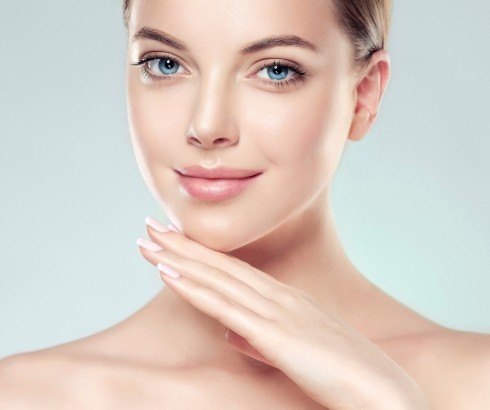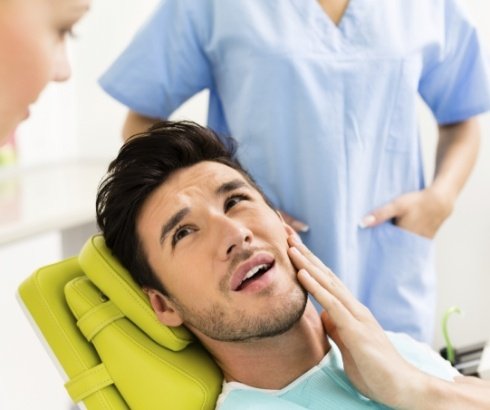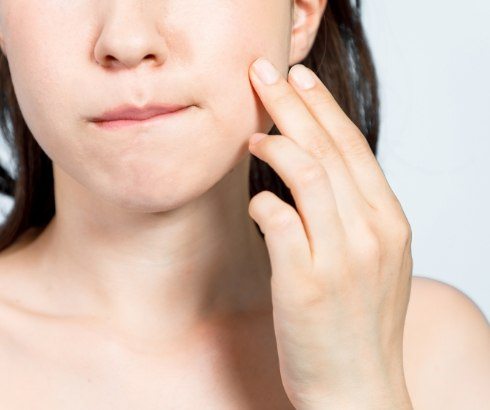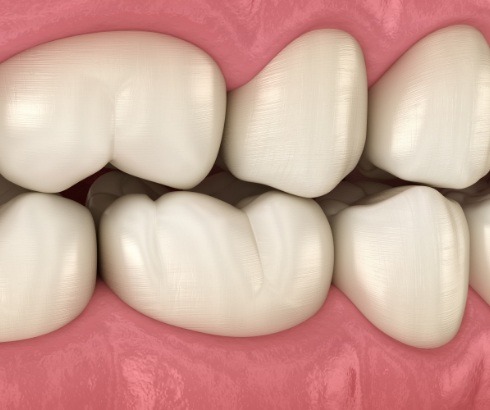BOTOX® – Portland, OR
Relax Overworked Facial Muscles
BOTOX® is often brought up in discussions about beauty and anti-aging treatments, but did you know that it has some medical applications as well? In fact, it can help to relax overworked facial muscles and address the bruxism (teeth grinding) that is often associated with sleep apnea. Dr. Teasdale and our team often incorporate BOTOX® injections into an individual’s comprehensive TMJ treatment plan to help their oral structures function harmoniously and comfortably. Read on below to learn more about how our dental team helps our patients and improves their quality of life with BOTOX for TMJ treatment and sleep apnea treatment in Portland.
Why Choose Evolution Dental for BOTOX® For TMJ Treatment & Sleep Apnea Treatment?
- Proven to Reduce TMJ Pain & Teeth Grinding
- Part of Comprehensive TMJ/Sleep Apnea Treatment Plan
- Precise Injections & Fast Results
How Does BOTOX® for Sleep Apnea & TMJ Treatment Work?
Evolution Dental is proud and excited to be one of the first dental offices to offer dental BOTOX® in Portland, OR, for the comfort and well-being of our patients! Whether it is for the treatment of bruxism, teeth grinding, teeth clenching, TMJ disorder (TMD), facial pain, or for the associated benefits of looking younger and less stressed, Dr. Teasdale and our experienced staff are happy to help you assess this wonderful option so you can look and feel your best.
BOTOX works by "turning down" the power of the muscles, much like that dimmer switch on your ceiling lights. When the muscles cannot respond as forcefully, they exert less power and use less energy. You can still chew, of course, but you might not be able to crush ice cubes or crunch corn nuts (two great things to avoid, anyway). Your teeth are not as stressed, your ice water sensitivity goes away, and, because your muscles are not overworking, your face becomes thinner, especially along the jaw. The jaw relaxes at night, moving downward and forward and making room for your tongue. And all is right in the world.
The Benefits of Dental BOTOX®

Few things are quite as predictable as BOTOX®, and, when used appropriately, there are very few negative side effects. Although we usually use it for immediate relief and then work with the patient for a more permanent solution, BOTOX may be used continuously for years without negative effects. It generally lasts for 90 days and leaves no residual effects. Our dental patients are generally astonished that they feel very little if any discomfort with the injections, and with how youthful and stress-free they appear afterward. Indeed, it is sometimes called a "facelift in a syringe", because the effects are often extremely dramatic.
Relieve TMJ Pain with BOTOX® Treatment

Dentists and physicians have known for decades that jaw pain is seldom the result of a bad temporomandibular joint (TMJ) but is rather due to the muscles moving excessively or in an unbalanced manner. As the muscles become stressed, they trigger discomfort and pain throughout the face, head, neck, and body. Sometimes, when stimulated, “trigger points” in the TMJ can cause pain to shoot to remote sites throughout the body. This discomfort can cause or increase migraine headaches, which can be quite debilitating and last for days.
When used properly, BOTOX® treatments for TMJ disorder can relieve and often block migraine headaches and soothe sore muscles for months at a time, providing patients with relief from symptoms they have suffered with for years. As a bonus, the same BOTOX injection used to treat TMJ discomfort can give patients a more youthful, energetic, and beautiful facial appearance-- what a wonderful perk!
BOTOX® for Teeth Grinding (Bruxism)

Teeth grinding and clenching (referred to when sleeping as bruxism) occur when the body mistakenly assumes that food is present and must be chewed. This is a reflex triggered when the back teeth rub together, and the sensory receptors in the bone mistake that contact as food, and tries to grind it away. Of course, it is not food but the teeth that are contacting, and so the result is grinding, clenching, and bruxism. Pretty straightforward, isn't it?
This tooth-to-tooth contact is actually pretty destructive. It can (and will) eventually wear the enamel off the contacting teeth. It will flex the teeth, causing notching near the gums, and rounded and receding gums. It can cause bone loss around the roots, and extreme sensitivity to ice water. And it can make your face "squarer", with the lower face looking more square, as the jaw muscles overwork and build bulk. Oh, and did we mention TMJ pain, just as an additional symptom? Or that this is a factor in the vast majority of obstructive sleep apnea cases, because, of course, when your teeth are grinding or clenching together, the space for your tongue is minimal, and it is displaced to the back of your throat, causing airway obstruction. Bruxism, grinding, and clenching: They just ain't no dang good.
The comprehensive long-term solution involves adjustment of the bite, or possibly rebuilding the bite, to where the muscles are comfortable and are not triggered to grind by tooth interferences. But in the short-run, one very effective way of easing the pain and symptoms may be with BOTOX®.
BOTOX® for Sleep Apnea & Bruxism Treatment

If you have obstructive sleep apnea or think you might, you should schedule a consultation with Dr. Teasdale. While sleep apnea is not something that Dr. Teasdale or any dentist can diagnose, in most cases, the disorder also causes bruxism, which IS a readily identifiable dental condition. Our conservative treatments, which may include either BOTOX® or highly specialized sleep guards, often resolve problems with sleep apnea and are a whole lot more comfortable than the use of a CPAP unit (as any CPAP-wearer will confirm).
Please call us to schedule a consultation to discuss how BOTOX® treatments for TMJ might be right for you. We are happy to work with you and your physician to provide you with the good night's sleep that your body needs and that you deserve. You cannot possibly look or feel your best without a good night’s rest. It is the key to everything!
Visit Us for a BOTOX® Consultation Today

There is a reason we are the Number 1 Dentist in Portland for BOTOX — just Google it and see for yourself. Then call us for a consultation to discover the wonderful things that BOTOX® may be able to bestow on you. Your comfort and appearance are what we are all about, our reason for being.
BOTOX FAQs
Dr. Teasdale and our team are eager to help you find relief from jaw pain, headaches, and more via therapeutic BOTOX injections. Before you request a consultation, however, we understand that you may want to learn more about the road in front of you. To help you out, we have curated the following list of FAQs, along with easy-to-understand answers. If you do not see your specific questions mentioned here, give us a call. We look forward to speaking with you.
Is BOTOX Safe?
BOTOX is a diluted form of botulinum toxin. Although the word “toxin” might seem scary, you can be confident that BOTOX is generally very safe. In fact, in the first 14 years after BOTOX received FDA approval, only 36 adverse events were reported. In a lot of those cases, the problem was related to a patient’s underlying medical conditions, rather than the BOTOX itself.
Plus, it is important to note that Dr. Teasdale has completed special training in the administration of BOTOX. Patient safety is a top priority for our team, and we never take needless risks with our patients’ health and safety.
Is BOTOX Permanent?
No, BOTOX is not permanent. It contains proteins that your body naturally metabolizes over time. For many people, the results of their injections last for anywhere from 3 to 6 months. The rate at which your body breaks down BOTOX depends on your age, your activity level, and other factors.
Although BOTOX can be used for years, we do not want to rely on it as a crutch. We primarily use BOTOX to help our patients experience fast pain relief while we work on a longer-term solution to the root cause of their TMD.
What Happens If I Stop BOTOX Injections?
With therapeutic BOTOX, we want you to stop taking it after the root cause of your jaw pain or other problems has been addressed. There are no noteworthy withdrawal symptoms.
If you choose to use BOTOX again in the future, whether it is for therapeutic purposes or to smooth out unwanted wrinkles, it is likely that you can do so safely.
Who Should Not Get BOTOX?
BOTOX is safe for most people, but there are some groups for whom it is not recommended, including:
- Pregnant and breastfeeding individuals.
- People with certain neuromuscular disorders, such as ALS or myasthenia gravis.
- People with certain respiratory conditions.
- Individuals with an allergy to cow’s milk protein (albumin). This is different from lactose, so even if you are lactose intolerant, it should be fine for you to receive BOTOX.
Before administering your injections our team will thoroughly screen you for any contraindications for BOTOX.
Does BOTOX Have Side Effects?
Yes, BOTOX can have side effects! If used to address bruxism, the injections into jaw muscles can cause temporary muscle weakness, affecting chewing and facial expressions, difficulty swallowing, pain or bruising at the injection site, and flu-like symptoms. For sleep apnea, potential side effects include dry mouth, hoarseness, and (in rare cases) breathing issues.
The good news is that most side effects are temporary and typically resolve within days to weeks. It’s crucial to consult a qualified healthcare professional to discuss benefits and risks specific to your condition. Being informed is incredibly helpful in making a well-rounded decision about using BOTOX for sleep apnea and bruxism.
At What Age is BOTOX Most Effective?
BOTOX for sleep apnea and bruxism is typically most effective for adults between the ages of 30 and 60. This age range is when people are likely to experience more pronounced symptoms due to factors like stress, age-related muscle changes, and lifestyle. Younger patients may not exhibit the severe symptoms that warrant BOTOX treatment, while older adults may have underlying conditions that complicate the treatment’s effectiveness. Be sure to consult with a professional to determine the appropriate age and suitability for BOTOX, as they can assess personal risk factors and benefits.
Why Is BOTOX So Popular?
BOTOX has become an incredibly popular treatment for sleep apnea and bruxism due to its effectiveness and minimally invasive nature. Unlike traditional methods, such as CPAP machines for sleep apnea or nightguards for bruxism, BOTOX offers a straightforward solution that doesn't require daily maintenance. It works by relaxing the muscles responsible for airway obstruction and teeth grinding, providing relief with just a few injections. Not only is it incredibly convenient, but it also offers relatively quick results.
Do I Need a Consultation Before Getting BOTOX?
Absolutely! BOTOX is a prescription medication that must be administered by a trained medical professional, making it crucial to discuss your treatment with a healthcare provider first. During the consultation, you'll cover essential topics such as your medical history, goals for treatment, possible side effects, and aftercare recommendations. This is also your chance to ask any questions you may have.
It's recommended to take at least 24 hours after your consultation to weigh the pros and cons before deciding on the treatment. The consultation can happen on the same day or up to a week before your scheduled BOTOX appointment. Ensuring you and your healthcare provider are aligned on expectations and understanding the treatment's implications is vital for satisfactory results. Moreover, a consultation is legally required before any medical treatments.
